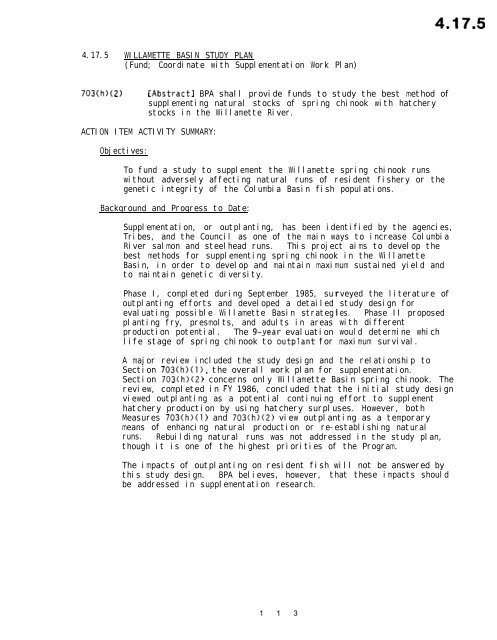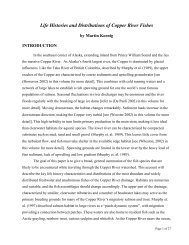- Page 3 and 4:
new research projects from the Fish
- Page 6:
1987Proqram4.6.14.14.14.15.14.16.1-
- Page 10:
1987ProgramPage8.13 DEVELOP MONITOR
- Page 13 and 14:
FY 1991 AIWPThe AIWP continues to f
- Page 15 and 16:
TABLE 1FY 1991 'rlORK PLAN PROJECTS
- Page 17 and 18:
TABLE 1 (cont.)FY 1991 WORK PLAN PR
- Page 19 and 20:
TABLE 1 (cont.)FY 1991 WORK PLAN PR
- Page 21 and 22:
TABLE 1 (cont.)FY 1991 WORK PLAN PR
- Page 23 and 24:
TABLE 1 (cont.)FY 1991 WORK PLAN PR
- Page 25 and 26:
TABLE 1 (cont.)FY 1991 WORK PLAN PR
- Page 27 and 28:
TABLE 2FY 1991 WORK PLAN PROJECTSW
- Page 29:
TABLE 3. ABBREVIATIONS USED IN THE
- Page 32 and 33:
FY 1991 FISH AND WILDLIFE PROGRAMAn
- Page 34 and 35:
BPA is responsible for developing t
- Page 36 and 37:
System Monitoring and EvaluationRes
- Page 38 and 39:
FIGURE 2, ORGANIZATION CHART: DIVIS
- Page 40 and 41:
negotiation, and management of cont
- Page 42 and 43:
2.1WATER BUDGET MEASURES303(a)303(b
- Page 44 and 45:
I. COMPLETED PROJECTSNone.II. FY 19
- Page 46 and 47:
2.22.2SMOLT MONITORING PROGRAM303(d
- Page 48 and 49:
PROJECTNUMBERTITLEPROJECT STATUSSCH
- Page 50 and 51:
PROJECTNUMBER TITLE PROJECT STATUS
- Page 52 and 53:
4.14.1 ELLENSBURG TOWN DIVERSION DA
- Page 54 and 55:
4.24.2 HABITAT AND PASSAGE IMPROVEM
- Page 56 and 57:
I. COMPLETED PROJECTSSee Table 4.II
- Page 58 and 59:
Table 4:Habitat Improvement and Pas
- Page 60 and 61: PROJECT11 2/NUMBER PO - PMCONTRACT
- Page 62 and 63: PROJECTNUMBER11 21PO - PMTITLE/OBJE
- Page 64 and 65: PROJECT11 21NUMBER PO - PMTITLE/OBJ
- Page 66 and 67: PROJECT11 21NUMBER PO - PM TITLE/OB
- Page 68 and 69: PROJECTI.1 21NUMBER -IT-~~JLE/OBJEC
- Page 70 and 71: PROJECT11 21NUMBER PO - PMCONTRACT
- Page 72 and 73: PROJECT11 21NUMBER PO - PM TITLE/OB
- Page 74 and 75: PROJECTNUMBER11 21PO - PMTITLE/OBJE
- Page 76 and 77: CONTRACT TERMPROJECT11 21 START REN
- Page 78 and 79: CONTRACT TERMPROJECT1/ 21 START REN
- Page 80 and 81: 4.44.4PROSSER DAM FISH PASSAGE FACI
- Page 82 and 83: ]. COMPIETED PROJECTSPROJECTNUMBERT
- Page 84 and 85: 4.64.6 WATER EXCHANGE FOR UMATILLA
- Page 86 and 87: 4.6.14.6.1 EVALUATE NON-STRUCTURAL
- Page 88 and 89: I. COMPLETED PROJECTSNone.JI. FY 19
- Page 90 and 91: t0cnc,rP2.rY-k:.r07Tal-a5ka. .:l/la
- Page 92 and 93: PROJECTOR TASKNUMBER TITLE PROJECT
- Page 94 and 95: PROJECTOR TASKNUMBER TITLE STATUS S
- Page 96 and 97: PROJECTOR TASKNUMBER TITIE PROJFCT
- Page 98 and 99: I. COMPLETED PROJECTSNone.II, FY 19
- Page 100 and 101: I. COMPLETED PROJECTSNone.II. FY 19
- Page 102 and 103: I. COMPLETED PROJECTSPROJECTNUMBER
- Page 104 and 105: 4.17.34.17.3 LOW-CAPITAL PROPAGATIO
- Page 106 and 107: 4.17.44.17.4 HABITAT SURVEY ASSOCIA
- Page 108 and 109: HATCHERY EFFECTIVENESS----- IMPROVE
- Page 112 and 113: Plans:Projects:BPA submitted the st
- Page 114 and 115: I. COMPLETED PROJECTSNone.II. FY 19
- Page 116 and 117: 5.15.1 KNOWN STOCK FISHERIES FIVE-Y
- Page 118 and 119: 2. Fish Disease Technical Work Grou
- Page 120 and 121: I. COMPLETED PROJECTSNone.II. FY 19
- Page 122 and 123: 1. RESERVOIR MORTALITY AND WATER BU
- Page 124 and 125: PROJECTNUMBERP R O J E C T SCHFDULE
- Page 126 and 127: PROJECTNUMBERTITLEPROJECT STATUSSCH
- Page 128 and 129: PROJECTNUMBERTITLEPROJECT STATUSSCH
- Page 130 and 131: PROJECTNUMBER TITLE PROJECT STATUSS
- Page 132 and 133: 2. FISH DISPASFI. COMPLFTED PROJECT
- Page 134 and 135: PROJECTNUMBER TITLE PROJFCT STATUSS
- Page 136 and 137: III. NEW PROJECTSPROJECTNUMBER TITL
- Page 138 and 139: PROJECTYUMBER TITLE PROJECT STATUS
- Page 140 and 141: PROJECTNUMBER TITLE PROJECT STATUS8
- Page 142 and 143: PROJECTNUMBERTITLEPROJECT STATUSSCH
- Page 144 and 145: PROJECTNUMBER TITLE PROJECT STATUS
- Page 146 and 147: 4. SUPPLEMENTATIONI. COMPLETED PROJ
- Page 148 and 149: PROJECTNUMBER TITLE PROJECT STATUS8
- Page 150 and 151: PROJECTNUMBER TITLE PROJFCT STATUS
- Page 152 and 153: 6.46.4 DATA COLLECTION FOR NATURAL
- Page 154 and 155: 6.106.10 SYSTEM MONITORING AND EVAL
- Page 156 and 157: PROJECTNUMBER TITLE PROJECT STATUSS
- Page 158 and 159: 6.126.12 CONTINUING COORDINATION AN
- Page 160 and 161:
7.17.1 COLVILLE HATCHERY(Complete C
- Page 162 and 163:
7.2 COEUR D'ALENE RESERVATION ACTIO
- Page 164 and 165:
7.37.3 KOKANEE SALMON HATCHERIES(Fu
- Page 166 and 167:
5hLoaF ‘; 5.r .F2 gl-4:a* +VI.r 4
- Page 168 and 169:
I. COMPLETED PROJECTSNone.JI. FY 19
- Page 170 and 171:
I. COMPLETED PROJECTSNone.1 1 .PROJ
- Page 172 and 173:
I. COMPLETED PROJECTSNone.11. FY 19
- Page 174 and 175:
I. COMPLETED PROJECTSNone.II. FY 19
- Page 176 and 177:
I. COMPLETED PROJECTSNone.II. FY 19
- Page 178 and 179:
7.117.11 ONGOING STUDIES IN MONTANA
- Page 180 and 181:
7.127.12 STURGEON STUDIES(Fund Ongo
- Page 182 and 183:
PROJECTNUMBERTITLESCHEDUIF AND MI1
- Page 184 and 185:
I. COMPLETED PROJECTSNone.II. FY 19
- Page 186 and 187:
7.147.14 IMPACTS OF DWORSHAK DAM(Be
- Page 188 and 189:
PROJECTNUMBER TITLE PROJECT STATUS
- Page 190 and 191:
I. COMPLETED PROJECTSNone.II. FY 19
- Page 192 and 193:
WILDLIFE ACTION ITEMS AND TECHNICAL
- Page 194 and 195:
STATUS OFTABLE 5ACTION ITEM 8.1 WIL
- Page 196 and 197:
PROJECTNUMBER TITLE PROJECT STATUSR
- Page 198 and 199:
TABLE 6STATUS OF ACTION ITEM 8.2 WI
- Page 200 and 201:
8.38.3 MITIGATION PLANS(Fund Develo
- Page 202 and 203:
I. COMPLETED PRQJECTSPROJECTNUMBER
- Page 205 and 206:
8.4 - 8.7a.4a.58.6a.7LIBBY DAM MITI
- Page 207 and 208:
I. COMPLETED PROJFCGPROJECTTITLEPRO
- Page 209 and 210:
PROJECTNUMBERTITLEPROJFCT STATUSSCH
- Page 211 and 212:
I. COMPLETED PROJECTSPROJECTNUMBER
- Page 213 and 214:
8.118.11 PUBLIC INVOLVEMENT ON MITI
- Page 215 and 216:
I. COMPLETED PROJECTSNone.II. FY 19
- Page 217 and 218:
8.138.13 DEVELOP MONITORING AND EVA
- Page 219 and 220:
I. COMPLETED PROJECTSNone.II. FY 19
- Page 221 and 222:
9.19.1 APPLICATION OF PROGRAM SECTI
- Page 223 and 224:
9.4 TURBINE INTAKE SCREENS(Develop
- Page 225 and 226:
10.1 - 10.3lO.l- EXPENDITURE AND OB
- Page 227 and 228:
----- PROGRAM-RELATED PROJECTSPROGR
- Page 229 and 230:
PROJECTNUMBER TITLE PROJECT STATUS
- Page 231 and 232:
PROJECTNUMBER TITLE _ PROJECT STATU
- Page 233 and 234:
VII, NON-ACTION ITEM PROJECTS2 6 5
- Page 235 and 236:
VIII, NON-PROGRAM, INTERNAL SUPPORT
- Page 237 and 238:
PROJECTNUMBER TITLE PROJECT STATUS
- Page 239 and 240:
PROJECTNUMBER TITLE PROJECT STATUS
- Page 241 and 242:
IX. APPENDIXLETTERS OF COMMENT ON T
- Page 243:
ADDENDUM TO FY 1991 AIWPREDUCTION L
















